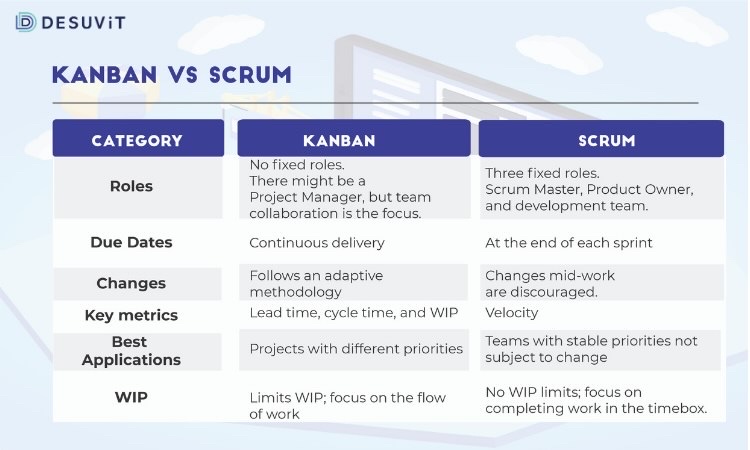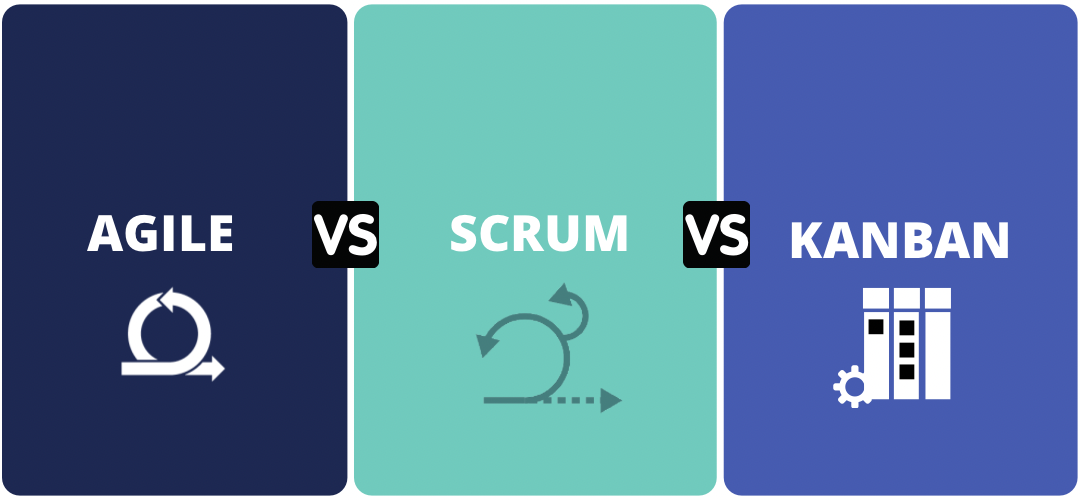Scrum and Kanban are Agile project management methodologies prevalent in the IT industry. On the surface level, these may seem similar, but they differ quite a bit in their inner workings.
The first most popular methodology to develop software was the Waterfall approach. It was a linear methodology to build software, which included predefined steps to follow. The steps were usually requirement gathering, system design, implementation, testing, deployment, and maintenance in that order. For many years software was developed using this approach. Although it had its advantage, the primary trouble with such a linear model was that the cost of changes was very high. If a change came in the testing phase, then all the steps needed to be performed again, increasing the cost of even the small change drastically. With the increasing demand for more feature-rich software and quick delivery requirement, it was apparent that the model was not the right fit to meet today’s needs. These challenges gave birth to Agile, which is now the primary way of building software.
The Agile Manifesto emphasizes interactions between individuals, active response for necessary changes, taking in customer feedback, and using working software instead of documentation. These are better brought to life when you read the 12 Principles behind the Agile Manifesto.
Scrum and Kanban were developed under the umbrella of Agile to meet different needs. These methodologies emphasize constant communication, testing, customer feedback, and response to change.
Let’s have a detailed insight into the three models and be able to differentiate between them.
What Is Agile?
The Agile methodology most prevalent in software development is about collaboration, self-organization, and a cross-functional approach. Its focus is on a flexible, simultaneous workflow. Agile is a broader category enveloping Scrum and Kanban.
Well-known software following Agile methodology includes Github and ClickUp.
What Is Kanban?
Kanban, a methodology within Agile, is about envisioning the work, reducing work in progress, and increasing efficiency. The primary focus of Kanban teams is to decrease the time needed for a particular project from the beginning till the end. To do so, they use a kanban board like Trello, Azure DevOps, or Jira to enhance workflow consistently.
What Is Scrum?
Also, under Agile methodology, Scrum project management employs an incremental approach for projects for quicker completion. You will most commonly see this methodology in software development and other intricate knowledge work.
The way it works is the team sends out functioning software in fixed intervals or sprints. Then they form learning loops to accumulate and blend in customer reports as quickly as possible. Groups use scrum software like Azure DevOps to allot specific roles, develop artifacts, and conduct routine ceremonies for faster progress.
What Is The Difference Between The Three?
By now, you can likely gauge that Agile is more of an umbrella term for project management methodologies. Its purpose is to segregate larger projects into smaller portions for easier handling.
Agile has been a go-to methodology for the software development industry for years. However, changing times are seeing its implementation in several other enterprises as well.
Agile is the guiding force behind other methodologies like Scrum and Kanban. So, in essence, Kanban and Scrum are the practices to adopt when you want to work in an agile manner.
It is easier to compare Scrum and Kanban’s differences since the two are distinct agile project management methodologies. We will be getting into the subtle differences between the two later. First, consider their similarities.
Both Scrum and Kanban employs board for people to segregate work into three categories:
- Work to be done
- Work in progress
- Work done
What Is The Difference Between Scrum And Kanban?
To make it easier to understand the answer to this question, consider this chart.

From the table, you can likely tell that Scrum has a more predefined work structure than Kanban. Teams following a Scrum methodology will lay down the plan of action in smaller segments before starting the project. That means they perform routine tasks in cycles according to the defined schedule.
While efficient at times, Scrum methodology can hold back the entire project in case of delays.
On the other hand, Kanban allows for the completion of work to be quicker and more frequent. That is because activities do not follow a set pattern. Instead, employees focus on the priority tasks after making a collective decision based on the board’s visual prompts.
Unique Features Of Each Method
In this section, we will consider just what makes each method unique from the other.
Agile
The following characteristics are inherent to all Agile methodologies:
- Simultaneous, segregated work: The method breaks projects into smaller portions. This segregation is useful as the work can then undergo user testing and regular revision.
- Adaptability: Since Agile methods incorporate smaller segments, they allow for more flexibility in working. That makes the methodology suitable for projects that expect frequent or unexpected alterations. Of course, you should avoid such changes whenever possible, but Agile helps you quickly make up for them if inevitable.
Kanban
Here are the features of Kanban that make it stand out:
- Kanban board: The Kanban boards allow visualization of the team workflow. Besides the work segregation, teams can add more categories wherever needed. You may record tasks on a Kanban card and then move them around as they progress through the group. The board keeps members informed about the status of tasks and helps identify problem areas. That means making corrections is far more manageable.
- WIP Limits: Kanban enforces a restriction on the number of tasks in progress at a particular time. The team itself decides the card limit. If you reach the limit, you cannot add a new project unless you complete one and move it to another list. With this, identifying bottlenecks becomes a lot simpler, and teams can work together to solve them.
- Continuous Improvement: A Kanban methodology allows teams to meet and discuss changes frequently. The data from the board helps guide these discussions. Such meetings can correct the workflow without dramatic changes.
Scrum
Here is what is unique to the Scrum methodology:
- Sprints: Scrum enforces two-week work completion. Planning of the sprint takes place in advance, and the team reviews it after execution. The team develops a sprint backlog, completing tasks during the sprint. They manage the work amongst themselves.
- Scrum Master: The Scrum Master is the connection between the product owner and the team. The Scrum Master understands the requirements of the product owner. Then he aids the team with the formation of sprints. During the sprint, he is the one to deal with any roadblocks.
- Burndown Charts: With this chart, team members get an overview of the progress. The burndown chart emphasizes the tasks yet to be completed rather than those finished.
Wrap Up
The primary distinction between these three approaches is that Agile is an umbrella term and has guiding principles that Scrum and Kanban follow in their implementation. Agile forms the basis for the two, which have branched out to have their distinct features.
For those partaking in projects that are prone to changes, Kanban is far more suitable. However, if you would prefer your team follow a systematic work style, then Scrum is for you. You may also choose to rely on Scrumban, which is a mix of the two. The method puts together the very best features of Scrum and Kanban into one package.
Still not sure which project management methodology works best for your team? Reach out to us for some advice. Our tons of experience in app and web development means we know just how to help you!
Desuvit is a Norway-born software development company delivering Custom Software Development, Mobile Apps, and Web Applications Development for various verticals and business domains. We offer end-to-end solutions for companies with no software or IT division, Startups, and companies that need to scale their software development efforts but lack the expertise required. We help our clients in growing their businesses so we can grow with them. Some of the technologies we work with: .Net, Azure, Microservices, Azure functions(Serverless computing), React Native, Flutter, React JS, TypeScript, Angular, NServiceBus, Azure Service Bus, Azure Queues, SQL Service, MySQL, Cosmos DB, etc.
Enjoyed this article? Subscribe for more valuable and great content !
By subscribing, you agree with our privacy policy and our terms of service.






